Upon arrival at the train's reception center, I wandered about the room, observing my fellow guests milling about, talking among themselves, or simply sitting on one the many available couches with the slightly glazed-over look that comes from having been exposed to too much sight-seeing over too short a time. Apart from two little girls racing about the room, shrieking and giggling, the room felt quiet and mildly uncomfortable.
There is a wine bar in a far corner of the room which offers up tastes of local vintages and not-so-local beer: Budweiser, Coors Lite, and Miller Genuine Draft. My initial, San Francisco-style reaction was one of shock. Where were the local brews? I looked around the room again and understood. The beer selection seemed, in a sense, a subtle way of telling its often out-of-their-element visitors, "See, we're just like you. We're not snobs, we just happen to live in the most famous wine region in the nation, so relax."
Before boarding the train, we were treated to a brief orientation by an affable, gravelly-voiced gentleman named Mike. Two wines were passed among the guests to sniff and taste. Well-acquainted with the general sense of intimidation that wine-tasting has upon the general public, Mike wiped away any perceived snobbery of wine enthusiasts in both his manner and his approach to tasting, even going so far as to make fun of people who sniff corks. "Why the hell would anyone sniff a cork? You're only going to smell cork. Corks are only presented to you at the table so you can tell if the wine has been stored properly." People laughed, relaxed a lot, and were now primed and ready for their wine-filled, three hour lunch through Wine Country which, in the minutes immediately preceeding Mike's presentation, might have seemed like slightly hostile, foreign territory.
Once through the reception line, where each group of guests is photographed by a Wine Train photographer, we boarded the train and were shown to our seats in the Vista Dome, a beautifully restored 1940's rail car. Surrounded by rich, red upholstery, white damask linen, and vintage silver flatware, we were poured glasses of Domaine Chandon Brut. If anything, I was feeling louche.
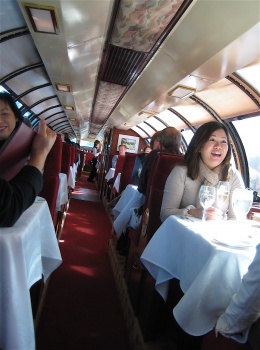
Our Bulgarian waiter was charming. As he stood at our table describing our luncheon options, I sat and listened, sipping my wine. I nodded a bit as he spoke, but stopped upon remembering that head signals are reversed in his native country. A nod implies disagreement, while a side-to-side shake implies assent. Or so I've heard. So, apart from letting my lips meet my champagne glass, I stopped moving my head entirely.
Soon after the train left the station, the stories of my lunchmates began. Off to my right was the restaurant where the Mondavis were told they could not bring their small dog. (The restaurant is, not surprisingly, no longer in existence). Off to the left, where a group of revellers (among whom my table companions counted themselves) mooned the Wine Train years ago, en masse. The Wine Train does, after all, have a reputation for offering breath-taking views.
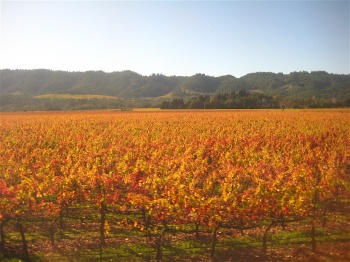
At the start of the first course, the train stopped for a few minutes. I asked if one of the managers who stopped by our table for a visit if people were boarding. "No", she replied, "just stopping to pick up a few supplies, that's all." I looked out the window at the Safeway and understood. I was somehow pleased by the fact that I was sitting in a moving restaurant. One that ran an errand or two as I sat, drinking my wine.
As the train resumed its journey, slowly rocking from side to side on its way, I marvelled at the waitstaff, who managed to make carrying plates of hot food and, even more impressive, trays of drinks, looks effortless. The service was efficient, friendly and wonderfully at-ease. It was even suggested that we take a break between the main course and dessert to stretch our legs and tour the rest of the train. We pass through the early-20th Century Pullman dining cars where three and four-course meals are served, the on-board kitchens, and the Silverado Car, where one has the option of selecting from an à la carte menu, or not at all, to the Tasting Bar, where we sampled a few local dessert wines before making the slow walk back to our table for coffee and dessert. On the journey back to our table, I noticed that many of the people who looked uneasy prior to boarding now looked incredibly relaxed.
The food was, sadly, fair-to-middling. For example, the Crêpe Rosettes stuffed with smoked salmon were mostly crêpe, with minimal participation from the salmon.
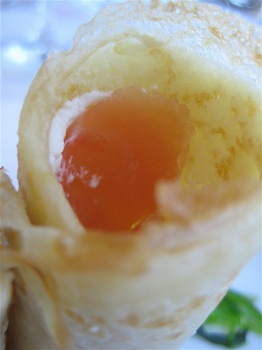
The Roasted Beef Tenderloin Wrapped in Bacon With Shallots, Leeks and Roasted Garlic in Chimichurri Sauce was well prepared but, as the name might suggest, it was a rather convoluted affair. There was not room enough on the menu to mention the mashed potatoes or the carrots which competed for space on the overcrowded plate.
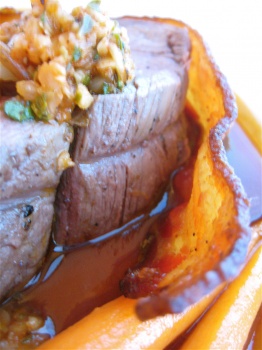
For dessert, I opted for the Calvados Apple Crisp with Vanilla Gelato. While the flavors were spot on-- just the proper hint of Calvados, the presentation destroyed what should have been a wonderful dessert. What arrived at our table merely looked like a cup of vanilla gelato, with no indication of what lay beneath. Crisp topping needs room to breathe. A complete smothering in gelato resulted in a cold mush with a texture approximating that of granola left too long in milk.
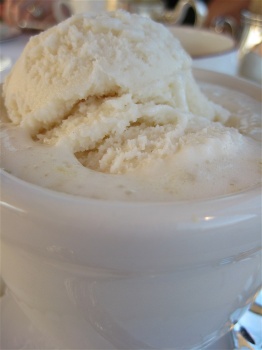
My sense is that-- and I may be shot for saying this-- Chef Kelly MacDonald is playing to a tourist audience, and rightly so. But I was left with the impression that the menu is an interpretation of what might play as "fancy"-- as gourmet-- to the tourist trade, which is doing no one any favors. The Napa Valley is home to some of the finest produce in the country. As a chef who proudly uses only fresh, local produce, it would do credit to himself and to the people visiting for the first time, to showcase that bounty in the simple, straightforward style of the valley through which the Napa Train takes its ride and from which it takes its name.
My criticism of the food aside, I had a fantastic time. A leisurely three-hour lunch in a beautifully-restored train car travelling at 18 mph through some of the most fantastic, autumn-colored countryside this region has to offer with a bottle or two of excellent, local wine selected from a well-crafted, affordable wine list to be drunk in hilarious company?
Yes, please. And I would do it again.
Whenever I visit a foreign city, I like to be blatantly touristy on my first day out by taking a narrated bus tour around town. I find it an excellent way of getting a general overview, a broad sense of the place. The Napa Wine Train is a great way to introduce visitors to the Valley, or yourself, for that matter, without having to fight the terrible traffic jams, especially in high-season. To borrow a jingle from a depressing and struggling national bus company, leave the driving to them.
Of course, it isn't driving, it's conducting or something. However trains work. I don't really want to know because, to borrow another jingle, there's something about a train that's magic. And I should like to leave it at that.
Instead, I suggest you follow the advice of this sign, found on the train:
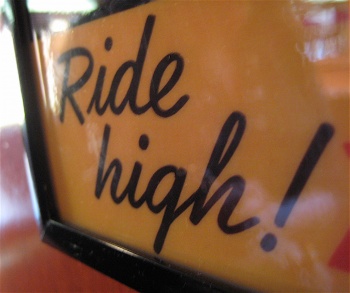
Ride high, and enjoy.
The Napa Valley Wine Train Station is located at:
1275 McKinstry Street
Napa, California 94559.
For Schedules and reservations, call:
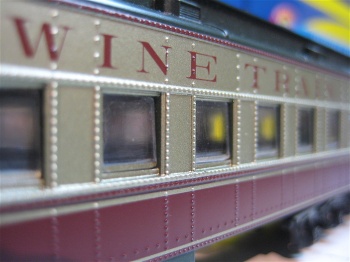 When my friend Karen asked me if I was interested in taking a trip on the Napa Valley Wine Train, I thought she was joking. She's a rather sophisticated woman-- one who lived in the Napa Valley for ten years. She must know something I don't. Or someone. That someone turned out to be Ryan Graham, director of the Wine Train's wine program-- an old friend of Karen's from her time at the infamous Bistro Don Giovanni.
When my friend Karen asked me if I was interested in taking a trip on the Napa Valley Wine Train, I thought she was joking. She's a rather sophisticated woman-- one who lived in the Napa Valley for ten years. She must know something I don't. Or someone. That someone turned out to be Ryan Graham, director of the Wine Train's wine program-- an old friend of Karen's from her time at the infamous Bistro Don Giovanni.




